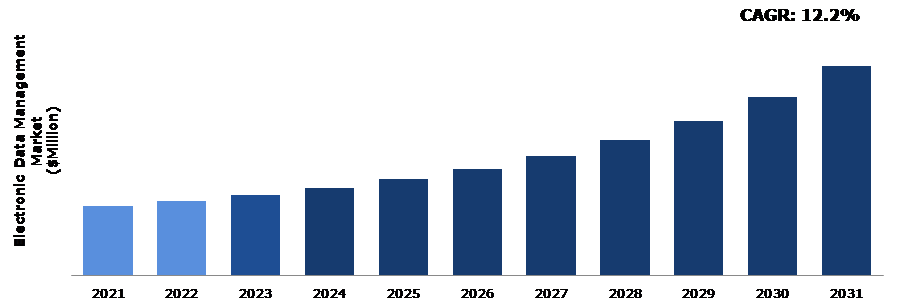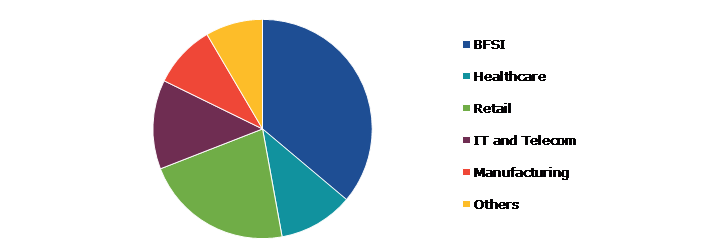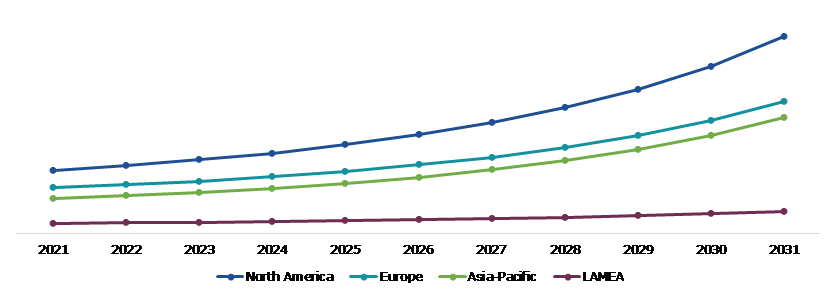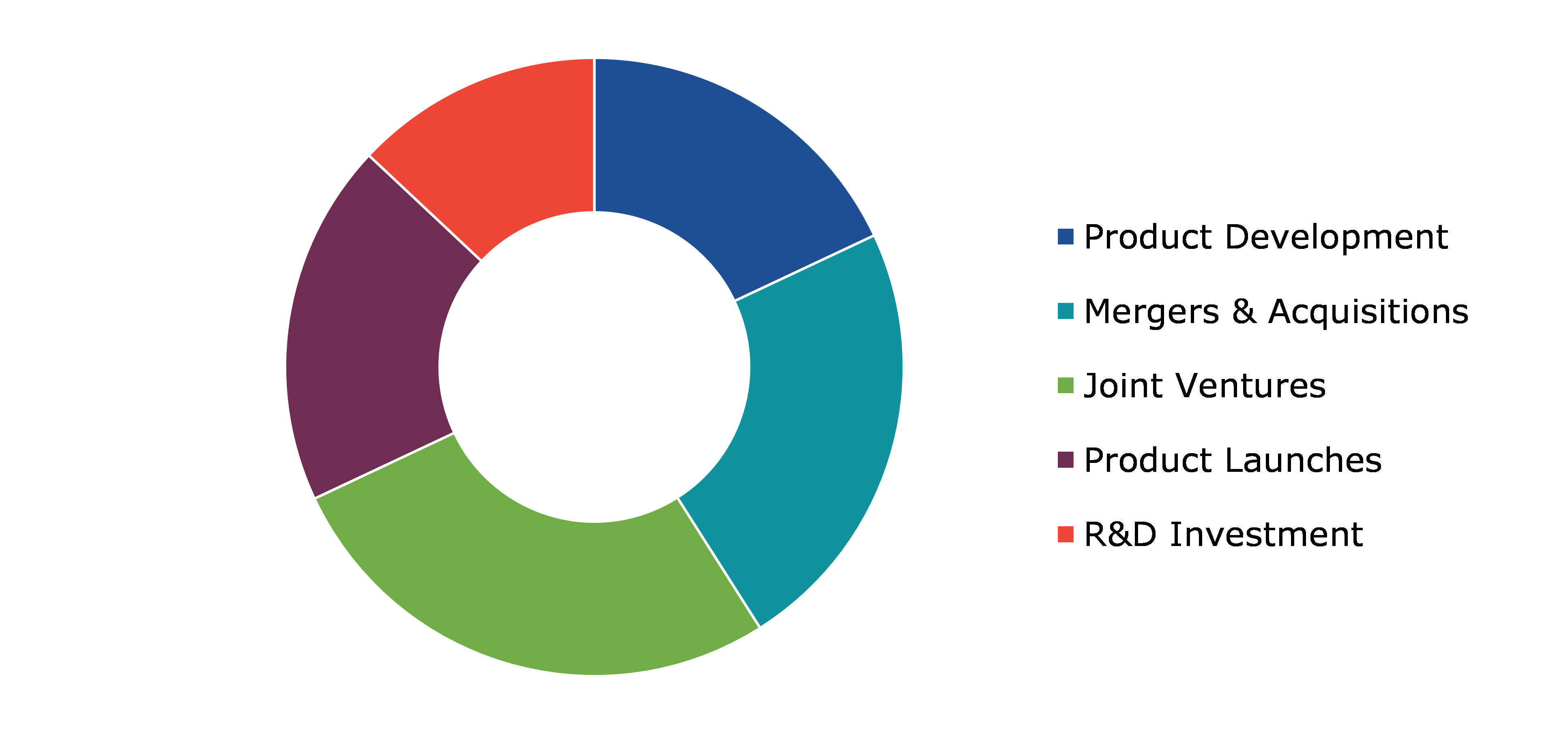Electronic Data Management Market Report
RA08664
Electronic Data Management Market by Offering (Solution and Services), Deployment Type (Cloud and On-premises), Organization Size (Large Enterprises and Small and Medium Enterprises), End-user (BFSI, Healthcare, Retail, IT and Telecom, Manufacturing, and Others), and Regional Analysis (North America, Europe, Asia-Pacific, and LAMEA): Global Opportunity Analysis and Industry Forecast, 2022–2031
Global Electronic Data Management Market Analysis
The Global Electronic Data Management Market Size was $6,348 million in 2021 and is predicted to grow with a CAGR of 12.2 % by generating a revenue of $19,289.5 million by 2031.
Global Electronic Data Management Market Synopsis
The electronic data management industry is being driven forward due to several factors. One of the primary factors is the increase in digitization of enterprises and the resulting data explosion. As businesses adopt more digital technology and conduct more of their business online, they generate massive volumes of data that must be handled, stored, and analyzed. This has resulted in a high need for electronic data management systems that may assist firms in efficiently storing, organizing, and retrieving their data. The increase in emphasis on regulatory compliance is another important factor. Various sectors such as finance and healthcare have stringent data security and privacy rules. Electronic data management systems can help these firms in ensuring compliance with these rules by offering safe storage and access restrictions, as well as capabilities for monitoring and reporting on data usage.
An electronic data management system's increased information sharing capacity poses a serious security danger to organizations Therefore, sensitive corporate data may fall into the wrong hands if sufficient safeguards are not put in place to prevent hacks. In addition, when the system is clogged with unnecessary records, record management could become an issue (such as duplicates). It is not unusual to come across circumstances where a sizable portion of the records kept resemble spam mail. These factors are projected to hamper the market growth during the forecast period.
The global electronic data management market is anticipated to grow significantly during the forecast period owing to the growing demand for real-time information, a structured process for data delivery from developers, and the efficient management of hierarchical master data produced across various verticals. In addition, the market development is anticipated to be driven by the growing need to ensure regulatory compliances and the rising adoption of IoT devices during the forecast period.
According to regional analysis, Asia-Pacific electronic data management market is anticipated to experience the fastest growth by 2031. Asia-Pacific is home to some of the world's fastest-growing countries such as China and India. As these countries continue to develop, there is a growing need for efficient and effective electronic data management solutions to support their digital transformation initiatives.
Electronic Data Management Overview
Electronic Data Management System (EDMS) is a software used to organize and keep all documentation in a single digital system. Self-built, specialized ‘on-premise,’ and cloud-based EDMS are some examples of EDMS. Electronic data management aims to give business paperwork discoverability, control, and structured and secure digital filing capabilities so it can operate efficiently. A singular source of truth provided by an EDM promotes collaboration and reduces wasteful spending for company.
COVID-19 Impact on Global Electronic Data Management Market
The COVID-19 pandemic had a major impact on the electronic data management market resulting in an increase in demand for EDM systems. The main reason for this is that vulnerable families and people can be tracked by EDM systems by combining age and population figures from school conscription, restricted tax information, and national paperwork. One reason for delayed implementation is budget constraints. With the economic impact of the pandemic, many organizations had to reduce their budgets for new projects, including implementing new EDM systems or upgrading existing ones. This resulted in delays in implementing EDM solutions, as organizations have had to prioritize other areas of their business. The pandemic has delayed the implementation of on-premises EDM systems in addition to budget and priority restrictions because it has disrupted the supply chain for hardware and software components. Delay in implementation is generally one of the pandemic's negative effects on the EDM market. However, it is anticipated that as the businesses start to recover, demand for EDM systems is expected to rise, spurring a surge in implementation and upgrades in the post-pandemic period.
Growing Applications of Electronic Data Management in Industrial Sector to Drive the Market Growth
The increase in usage of corporate data management by clients working in various end-use sectors is the main factor anticipated to boost the market development. In addition, the need for risk management is expected to grow during the forecast period. Risk management systems help the company manage its risk and optimize its database management opportunities. Therefore, electronic data management solutions that provide mobile access to data are becoming more popular owing to the increase in use of mobile devices. Mobile access allows employees to access and manage data from anywhere, at any time, improving productivity and collaboration. Electronic data management systems are increasingly being integrated with other business systems, such as CRM, ERP, and supply chain management software. This integration streamlines business processes and improves overall efficiency.
To know more about global electronic data management market drivers, get in touch with our analysts here.
High Risk of Cyber Attacks is Expected to Hamper the Electronic Data Management Industry
There is an increased risk of security breaches, hacking, and other cyber threats as the electronic data becomes more prevalent. Lack of cybersecurity measures to protect sensitive data from unauthorized access is expected to hamper the market demand. Electronic data is vulnerable to unauthorized access and theft, either through hacking or other cyberattacks, or through human error, such as misplacing a laptop or mobile device containing sensitive data. This is one of the major factors anticipated to hinder the electronic data management market growth in the upcoming years.
Use of Electronic Data Management for Maintaining Data to Drive Excellent Opportunities in the Market
Electronic data management (EDM) gives top priority to data maintenance because maintaining the data can have a significant impact on an organization's efficiency and decision-making. In addition, the market growth is being positively impacted by the increase in demand for real-time data management among businesses. Enterprises currently have a ton of unorganized data and they are able to create and pull useful information in real-time using EDM. The increase in demand from the IT, financial, and other industries for readily available data will have a big effect on the electronic data management industry.
To know more about global electronic data management market opportunities, get in touch with our analysts here.
Global Electronic Data Management Market, by Offering
Based on offering, the market has been divided into solution and services. Among these, the solution sub-segment accounted for the highest market share in 2021, whereas the services sub-segment is estimated to show the fastest growth during the forecast period.
Global Electronic Data Management Market Size, by Offering, 2021
Source: Research Dive Analysis
The solutions segment accounted for a dominant market share in 2021. In the BFSI industry, document management solutions are crucial. Traditional data management techniques can make it difficult to handle loan agreements, financial statements, and multiple hard copies efficiently. Players in the market for electronic data management solutions provide the BFSI industry with significant financial gains so that it can avoid unnecessary printing and paper-based costs. In addition, role-based access protects users' private data and prevents it from becoming a target of malicious activities.
The services segment is anticipated to show the fastest growth by 2031. Services can aid in staffing optimization, collaboration enhancement, and automation of time and expenditure management. Spreadsheets have long been used by small companies for various purposes, including resource and time management. Enterprises frequently struggle to maintain business quality, increase throughput, improve effectiveness, and ideally align resources while successfully completing projects on schedule, necessitating the need to automate these tasks as the business expands and complexity rises. The services segment development is expected to be driven by the expanding need to increase operational effectiveness during the forecast period.
Global Electronic Data Management Market, by Deployment Type
Based on deployment type, the market has been divided into cloud and on-premises. Among these, the on-premises sub-segment accounted for highest revenue share in 2021.
Global Electronic Data Management Market Forecast, by Deployment Type, 2021
Source: Research Dive Analysis
The on-premises segment accounted for a dominant market in 2021. On-premises software is now more in demand as many organizations are switching from manual to automated systems to carry out different tasks. Many businesses are choosing on-premises deployment due to the improved security features. In addition, some corporate data management tools can be easily customized to the requirements of the company and operate without an Internet connection. These factors will likely cause the on-premises segment to expand steadily during the forecast period.
Global Electronic Data Management Market, by Organization Size
Based on organization size, the market has been divided into large enterprises and small and medium enterprises. Among these, the large enterprises sub-segment accounted for the highest revenue share in 2021.
Global Electronic Data Management Market Share, by Organization Size, 2021
Source: Research Dive Analysis
The large enterprises segment accounted for a dominant market share in 2021. Large businesses frequently access, use, produce, and handle enormous amounts of data. Enterprise software solutions are frequently adopted by large businesses because their business operations frequently require the use of high-tech tools like real-time data compilation tools, sophisticated analytical engines, and process blueprints. In addition, the demand for enterprise data management solutions is anticipated to be driven by large enterprises' strong focus on adopting operative data tactics to classify and predict potential threats and use this data to make faster business decisions.
Global Electronic Data Management Market, by End-user
Based on end-user, the market has been divided into BFSI, healthcare, retail, IT and telecom, manufacturing, and others. Among these, the BFSI sub-segment accounted for the highest revenue share in 2021.
Global Electronic Data Management Market Growth, by End-user, 2021
Source: Research Dive Analysis
The BFSI sub-segment accounted for a dominant market share in 2021. The adoption of EDM solutions can aid current players in the BFSI sector in more effectively managing enterprise-wide risks, enhancing sales and marketing operations, recording and monitoring financial and accounting processes, and efficiently handling various compliances. For instance, banking institutions around the world have adopted advanced agile methods to safeguard their data and guarantee accurate data quality. The BFSI sector is adopting EDM solutions due to these technological developments.
Global Electronic Data Management Market, Regional Insights
The electronic data management market was investigated across North America, Europe, Asia-Pacific, and LAMEA.
Global Electronic Data Management Market Size & Forecast, by Region, 2021-2031 (USD Million)
Source: Research Dive Analysis
The Market for Electronic Data Management in North America was the Most Dominant
The North America market accounted for a dominant market share in 2021. The expansion of the regional market can be attributed to the increase in demand for timely, accurate information as well as the demand for risk management solutions. A number of businesses in the region, including IBM, Oracle, Amazon Web Services, and others, place a strong stress on digital transformation and are frequently regarded as early adopters of cutting-edge technologies like IoT, big data analytics, AI, and machine learning. For instance, in May 2021, Catalogic Software, a top supplier of data protection and copy data management solutions for various industries, was acquired by IBM Corp. The emphasis on enterprise and cloud data protection solutions and data security would be made possible by this acquisition for Catalogic Software. The region's businesses' ongoing adoption of these cutting-edge technologies is encouraging the market expansion.
Competitive Scenario in the Global Electronic Data Management Market
Investment and agreement are common strategies followed by major market players. For instance, on October 24, 2019, NetApp an electronic data management company revealed a collaboration with DreamWorks Studios team to optimize the data fabric and meet the studio's unique, rapidly expanding data storage and management needs.
Source: Research Dive Analysis
Some of the leading electronic data management market players are Microsoft Corporation, Oracle Corporation, Open Text Corporation, Hyland Software, Inc, IBM Corporation, Xerox Corporation, Adobe Inc, KYOCERA Document Solutions Inc., Konica Minolta, INC., and Exela Technologies, Inc.
| Aspect | Particulars |
| Historical Market Estimations | 2020-2021 |
| Base Year for Market Estimation | 2021 |
| Forecast Timeline for Market Projection | 2022-2031 |
| Geographical Scope | North America, Europe, Asia-Pacific, and LAMEA |
| Segmentation by Offering |
|
| Segmentation by Deployment Type |
|
| Segmentation by Organization Size |
|
| Segmentation by End-user |
|
| Key Companies Profiled |
|
Q1. What is the size of the global electronic data management market?
A. The size of the global electronic data management market was over $6,348 million in 2021 and is projected to reach $19,289.5 million by 2031.
Q2. Which are the major companies in the electronic data management market?
A. International Business, Corp., Oracle Corp, SAP SE, and Cloudera, Inc are some of the key players in the global electronic data management market.
Q3. Which region, among others, possesses greater investment opportunities in the future?
A. North America possesses great investment opportunities for investors in the future.
Q4. What will be the growth rate of the Asia-Pacific electronic data management market?
A. Asia-Pacific electronic data management market is anticipated to grow at 13.3%% CAGR during the forecast period.
Q5. What are the strategies opted by the leading players in this market?
A. Agreement and investment are the two key strategies opted by the operating companies in this market.
Q6. Which companies are investing more on R&D practices?
A. International Business, Corp., Oracle Corp, SAP SE, Cloudera, Inc., and Amazon Web Services, Inc are the companies investing more on R&D activities for developing new products and technologies.
1.Research Methodology
1.1.Desk Research
1.2.Real time insights and validation
1.3.Forecast model
1.4.Assumptions and forecast parameters
1.5.Market size estimation
1.5.1.Top-down approach
1.5.2.Bottom-up approach
2.Report Scope
2.1.Market definition
2.2.Key objectives of the study
2.3.Report overview
2.4.Market segmentation
2.5.Overview of the impact of COVID-19 on Global electronic data management market
3.Executive Summary
4.Market Overview
4.1.Introduction
4.2.Growth impact forces
4.2.1.Drivers
4.2.2.Restraints
4.2.3.Opportunities
4.3.Market value chain analysis
4.3.1.List of raw material suppliers
4.3.2.List of manufacturers
4.3.3.List of distributors
4.4.Innovation & sustainability matrices
4.4.1.Technology matrix
4.4.2.Regulatory matrix
4.5.Porter’s five forces analysis
4.5.1.Bargaining power of suppliers
4.5.2.Bargaining power of consumers
4.5.3.Threat of substitutes
4.5.4.Threat of new entrants
4.5.5.Competitive rivalry intensity
4.6.PESTLE analysis
4.6.1.Political
4.6.2.Economical
4.6.3.Social
4.6.4.Technological
4.6.5.Environmental
4.7.Impact of COVID-19 on electronic data management market
4.7.1.Pre-covid market scenario
4.7.2.Post-covid market scenario
5.Electronic Data Management Market Analysis, by Offering
5.1.Overview
5.2.Solution
5.2.1.Definition, key trends, growth factors, and opportunities
5.2.2.Market size analysis, by region, 2021-2031
5.2.3.Market share analysis, by country, 2021-2031
5.3.Services
5.3.1.Definition, key trends, growth factors, and opportunities
5.3.2.Market size analysis, by region, 2021-2031
5.3.3.Market share analysis, by country, 2021-2031
5.4.Research Dive Exclusive Insights
5.4.1.Market attractiveness
5.4.2.Competition heatmap
6.Electronic Data Management Market Analysis, by Deployment Type
6.1.Overview
6.2.On-premises
6.2.1.Definition, key trends, growth factors, and opportunities
6.2.2.Market size analysis, by region, 2021-2031
6.2.3.Market share analysis, by country, 2021-2031
6.3.Cloud
6.3.1.Definition, key trends, growth factors, and opportunities
6.3.2.Market size analysis, by region, 2021-2031
6.3.3.Market share analysis, by country, 2021-2031
6.4.Research Dive Exclusive Insights
6.4.1.Market attractiveness
6.4.2.Competition heatmap
7.Electronic Data Management Market Analysis, by Organization Size
7.1.Overview
7.2.Large Enterprises
7.2.1.Definition, key trends, growth factors, and opportunities
7.2.2.Market size analysis, by region, 2021-2031
7.2.3.Market share analysis, by country, 2021-2031
7.3.Small and Medium Enterprises
7.3.1.Definition, key trends, growth factors, and opportunities
7.3.2.Market size analysis, by region, 2021-2031
7.3.3.Market share analysis, by country, 2021-2031
7.4.Research Dive Exclusive Insights
7.4.1.Market attractiveness
7.4.2.Competition heatmap
8.Electronic Data Management Market Analysis, by End-user
8.1.BFSI
8.1.1.Definition, key trends, growth factors, and opportunities
8.1.2.Market size analysis, by region, 2021-2031
8.1.3.Market share analysis, by country, 2021-2031
8.2.Healthcare
8.2.1.Definition, key trends, growth factors, and opportunities
8.2.2.Market size analysis, by region, 2021-2031
8.2.3.Market share analysis, by country, 2021-2031
8.3.Retail
8.3.1.Definition, key trends, growth factors, and opportunities
8.3.2.Market size analysis, by region, 2021-2031
8.3.3.Market share analysis, by country, 2021-2031
8.4.IT and Telecom
8.4.1.Definition, key trends, growth factors, and opportunities
8.4.2.Market size analysis, by region, 2021-2031
8.4.3.Market share analysis, by country, 2021-2031
8.5.Manufacturing
8.5.1.Definition, key trends, growth factors, and opportunities
8.5.2.Market size analysis, by region, 2021-2031
8.5.3.Market share analysis, by country, 2021-2031
8.6.Others
8.6.1.Definition, key trends, growth factors, and opportunities
8.6.2.Market size analysis, by region, 2021-2031
8.6.3.Market share analysis, by country, 2021-2031
8.7.Research Dive Exclusive Insights
8.7.1.Market attractiveness
8.7.2.Competition heatmap
9.Electronic Data Management Market, by Region
9.1.North America
9.1.1.U.S.
9.1.1.1.Market size analysis, by Offering, 2021-2031
9.1.1.2.Market size analysis, by Deployment Type, 2021-2031
9.1.1.3.Market size analysis, by Organization Size, 2021-2031
9.1.1.4.Market size analysis, by End-user, 2021-2031
9.1.2.Canada
9.1.2.1.Market size analysis, by Offering, 2021-2031
9.1.2.2.Market size analysis, by Deployment Type, 2021-2031
9.1.2.3.Market size analysis, by Organization Size, 2021-2031
9.1.2.4.Market size analysis, by End-user, 2021-2031
9.1.3.Mexico
9.1.3.1.Market size analysis, by Offering, 2021-2031
9.1.3.2.Market size analysis, by Deployment Type, 2021-2031
9.1.3.3.Market size analysis, by Organization Size, 2021-2031
9.1.3.4.Market size analysis, by End-user, 2021-2031
9.1.4.Research Dive Exclusive Insights
9.1.4.1.Market attractiveness
9.1.4.2.Competition heatmap
9.2.Europe
9.2.1.Germany
9.2.1.1.Market size analysis, by Offering, 2021-2031
9.2.1.2.Market size analysis, by Deployment Type, 2021-2031
9.2.1.3.Market size analysis, by Organization Size, 2021-2031
9.2.1.4.Market size analysis, by End-user, 2021-2031
9.2.2.UK
9.2.2.1.Market size analysis, by Offering, 2021-2031
9.2.2.2.Market size analysis, by Deployment Type, 2021-2031
9.2.2.3.Market size analysis, by Organization Size, 2021-2031
9.2.2.4.Market size analysis, by End-user, 2021-2031
9.2.3.France
9.2.3.1.Market size analysis, by Offering, 2021-2031
9.2.3.2.Market size analysis, by Deployment Type, 2021-2031
9.2.3.3.Market size analysis, by Organization Size, 2021-2031
9.2.3.4.Market size analysis, by End-user, 2021-2031
9.2.4.Spain
9.2.4.1.Market size analysis, by Offering, 2021-2031
9.2.4.2.Market size analysis, by Deployment Type, 2021-2031
9.2.4.3.Market size analysis, by Organization Size, 2021-2031
9.2.4.4.Market size analysis, by End-user, 2021-2031
9.2.5.Italy
9.2.5.1.Market size analysis, by Offering, 2021-2031
9.2.5.2.Market size analysis, by Deployment Type, 2021-2031
9.2.5.3.Market size analysis, by Organization Size, 2021-2031
9.2.5.4.Market size analysis, by End-user, 2021-2031
9.2.6.Rest of Europe
9.2.6.1.Market size analysis, by Offering, 2021-2031
9.2.6.2.Market size analysis, by Deployment Type, 2021-2031
9.2.6.3.Market size analysis, by Organization Size, 2021-2031
9.2.6.4.Market size analysis, by End-user, 2021-2031
9.2.7.Research Dive Exclusive Insights
9.2.7.1.Market attractiveness
9.2.7.2.Competition heatmap
9.3.Asia-Pacific
9.3.1.China
9.3.1.1.Market size analysis, by Offering, 2021-2031
9.3.1.2.Market size analysis, by Deployment Type, 2021-2031
9.3.1.3.Market size analysis, by Organization Size, 2021-2031
9.3.1.4.Market size analysis, by End-user, 2021-2031
9.3.2.Japan
9.3.2.1.Market size analysis, by Offering, 2021-2031
9.3.2.2.Market size analysis, by Deployment Type, 2021-2031
9.3.2.3.Market size analysis, by Organization Size, 2021-2031
9.3.2.4.Market size analysis, by End-user, 2021-2031
9.3.3.India
9.3.3.1.Market size analysis, by Offering, 2021-2031
9.3.3.2.Market size analysis, by Deployment Type, 2021-2031
9.3.3.3.Market size analysis, by Organization Size, 2021-2031
9.3.3.4.Market size analysis, by End-user, 2021-2031
9.3.4.Australia
9.3.4.1.Market size analysis, by Offering, 2021-2031
9.3.4.2.Market size analysis, by Deployment Type, 2021-2031
9.3.4.3.Market size analysis, by Organization Size, 2021-2031
9.3.4.4.Market size analysis, by End-user, 2021-2031
9.3.5.South Korea
9.3.5.1.Market size analysis, by Offering, 2021-2031
9.3.5.2.Market size analysis, by Deployment Type, 2021-2031
9.3.5.3.Market size analysis, by Organization Size, 2021-2031
9.3.5.4.Market size analysis, by End-user, 2021-2031
9.3.6.Rest of Asia-Pacific
9.3.6.1.Market size analysis, by Offering, 2021-2031
9.3.6.2.Market size analysis, by Deployment Type, 2021-2031
9.3.6.3.Market size analysis, by Organization Size, 2021-2031
9.3.6.4.Market size analysis, by End-user, 2021-2031
9.3.7.Research Dive Exclusive Insights
9.3.7.1.Market attractiveness
9.3.7.2.Competition heatmap
9.4.LAMEA
9.4.1.Brazil
9.4.1.1.Market size analysis, by Offering, 2021-2031
9.4.1.2.Market size analysis, by Deployment Type, 2021-2031
9.4.1.3.Market size analysis, by Organization Size, 2021-2031
9.4.1.4.Market size analysis, by End-user, 2021-2031
9.4.2.Saudi Arabia
9.4.2.1.Market size analysis, by Offering, 2021-2031
9.4.2.2.Market size analysis, by Deployment Type, 2021-2031
9.4.2.3.Market size analysis, by Organization Size, 2021-2031
9.4.2.4.Market size analysis, by End-user, 2021-2031
9.4.3.UAE
9.4.3.1.Market size analysis, by Offering, 2021-2031
9.4.3.2.Market size analysis, by Deployment Type, 2021-2031
9.4.3.3.Market size analysis, by Organization Size, 2021-2031
9.4.3.4.Market size analysis, by End-user, 2021-2031
9.4.4.South Africa
9.4.4.1.Market size analysis, by Offering, 2021-2031
9.4.4.2.Market size analysis, by Deployment Type, 2021-2031
9.4.4.3.Market size analysis, by Organization Size, 2021-2031
9.4.4.4.Market size analysis, by End-user, 2021-2031
9.4.5.Rest of LAMEA
9.4.5.1.Market size analysis, by Offering, 2021-2031
9.4.5.2.Market size analysis, by Deployment Type, 2021-2031
9.4.5.3.Market size analysis, by Organization Size, 2021-2031
9.4.5.4.Market size analysis, by End-user, 2021-2031
9.4.6.Research Dive Exclusive Insights
9.4.6.1.Market attractiveness
9.4.6.2.Competition heatmap
10.Competitive Landscape
10.1.Top winning strategies, 2021
10.1.1.By strategy
10.1.2.By year
10.2.Strategic overview
10.3.Market share analysis, 2021
11.Company Profiles
11.1.Microsoft Corporation
11.1.1.Overview
11.1.2.Business segments
11.1.3.Product portfolio
11.1.4.Financial performance
11.1.5.Recent developments
11.1.6.SWOT analysis
11.2.Oracle Corporation
11.2.1.Overview
11.2.2.Business segments
11.2.3.Product portfolio
11.2.4.Financial performance
11.2.5.Recent developments
11.2.6.SWOT analysis
11.3.Open Text Corporation
11.3.1.Overview
11.3.2.Business segments
11.3.3.Product portfolio
11.3.4.Financial performance
11.3.5.Recent developments
11.3.6.SWOT analysis
11.4.Hyland Software, Inc.
11.4.1.Overview
11.4.2.Business segments
11.4.3.Product portfolio
11.4.4.Financial performance
11.4.5.Recent developments
11.4.6.SWOT analysis
11.5.IBM Corporation
11.5.1.Overview
11.5.2.Business segments
11.5.3.Product portfolio
11.5.4.Financial performance
11.5.5.Recent developments
11.5.6.SWOT analysis
11.6.Teradata.
11.6.1.Overview
11.6.2.Business segments
11.6.3.Product portfolio
11.6.4.Financial performance
11.6.5.Recent developments
11.6.6.SWOT analysis
11.7.Xerox Corporation
11.7.1.Overview
11.7.2.Business segments
11.7.3.Product portfolio
11.7.4.Financial performance
11.7.5.Recent developments
11.7.6.SWOT analysis
11.8.Adobe Inc.
11.8.1.Overview
11.8.2.Business segments
11.8.3.Product portfolio
11.8.4.Financial performance
11.8.5.Recent developments
11.8.6.SWOT analysis
11.9.KYOCERA Document Solutions Inc.
11.9.1.Overview
11.9.2.Business segments
11.9.3.Product portfolio
11.9.4.Financial performance
11.9.5.Recent developments
11.9.6.SWOT analysis
11.10.Konica Minolta, INC.
11.10.1.Overview
11.10.2.Business segments
11.10.3.Product portfolio
11.10.4.Financial performance
11.10.5.Recent developments
11.10.6.SWOT analysis
Electronic data management refers to organizing and managing complex data points that an organization or an enterprise generates. With the IT revolution, the scope of digitization has increased tremendously which is why global organizations generate loads of data which needs to be managed regularly. To meet this demand, many electronic data management systems have been launched which are essentially software systems that offer an effective way to store and organize digital and scanned documents. For this purpose, these systems also employ cloud services so that the complete data can be stored in one place.
Forecast Analysis of the Electronic Data Management Market
Increasing digitization of enterprises and organizations across the world is expected to be the primary growth driver of the global electronic data management market in the forecast period. Along with this, growing applications of electronic data management systems in industrial sector is predicted to boost the market in the analysis timeframe. Moreover, the increase in emphasis on regulatory compliance in financial sectors is expected to offer numerous growth opportunities to the market in the forecast years. However, according to the market analysts, high risk of cyber-attacks might become a hurdle in the full-fledged growth of the electronic data management market in the 2022-2031 timeframe.
Regionally, the electronic data management market in the North America region is expected to be the most dominant in the forecast period. Increased demand for risk management solutions from several IT companies is predicted to be the main contributing factor to the growth of the market in the forecast period.
As per a report by Research Dive, the global electronic data management market is expected to reach a revenue of $19,289.5 million in the 2022–2031 timeframe, thereby growing at CAGR of 12.2% by 2031. Some prominent market players include Microsoft Corporation, IBM Corporation, KYOCERA Document Solutions Inc., Oracle Corporation, Xerox Corporation, Konica Minolta, INC., Open Text Corporation, Adobe Inc, Exela Technologies, Inc., Hyland Software, Inc, and many others.
Covid-19 Impact on the Electronic Data Management Market
The Covid-19 pandemic and the subsequent lockdowns have had a catastrophic impact on various businesses and markets worldwide. The electronic data management market, however, has been an exception. The pandemic saw a general growth in the demand for electronic data systems from various companies to organize their data. This led to a growth in the market during the pandemic years.
Significant Market Developments
The key players of the market are adopting various business strategies such as partnerships, mergers & acquisitions, and launches to gain a leading position in the market, thus helping the electronic data management market to flourish. For instance:
- In August 2022, Cybernetik Technologies Pvt Ltd, an industrial automation company, announced that it was partnering with CloudFronts, a data management company. This partnership is mainly aimed at CloudFronts managing the data of Cybernetik Technologies efficiently. The partnership is predicted to help both the companies to increase their footprint in their respective industries.
- In March 2023, Accelex, a leading software-as-a-service platform, announced the launch of the first-of-its-kind document acquisition solution for private markets. This data management solution, as per Accelex, offers an efficient way for data collection and management for investors and asset managers. The product launch is anticipated to help the company to expand its market share substantially in the coming period.
- In April 2023, SAP, a global software company, announced the launch of its flagship software called SAP Datasphere. SAP Datasphere is a cloud data warehouse service which helps in managing and structuring cloud data and offers services like data cataloging. The product launch is predicted to help SAP to consolidate its position as the leader of the industry in the next few years.
Personalize this research
- Triangulate with your own data
- Request your format and definition
- Get a deeper dive on a specific application, geography, customer or competitor
- + 1-888-961-4454 Toll - Free
- support@researchdive.com








